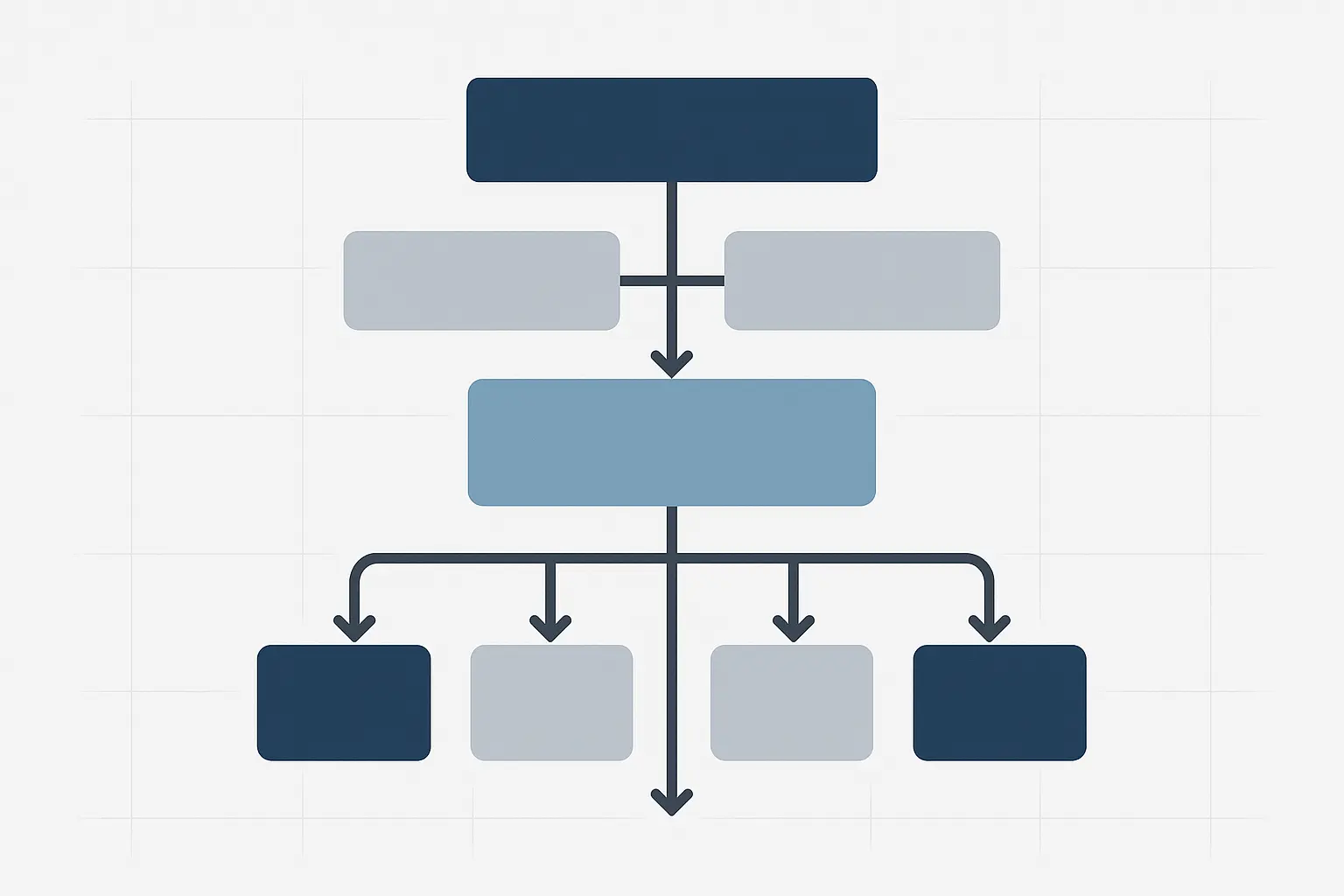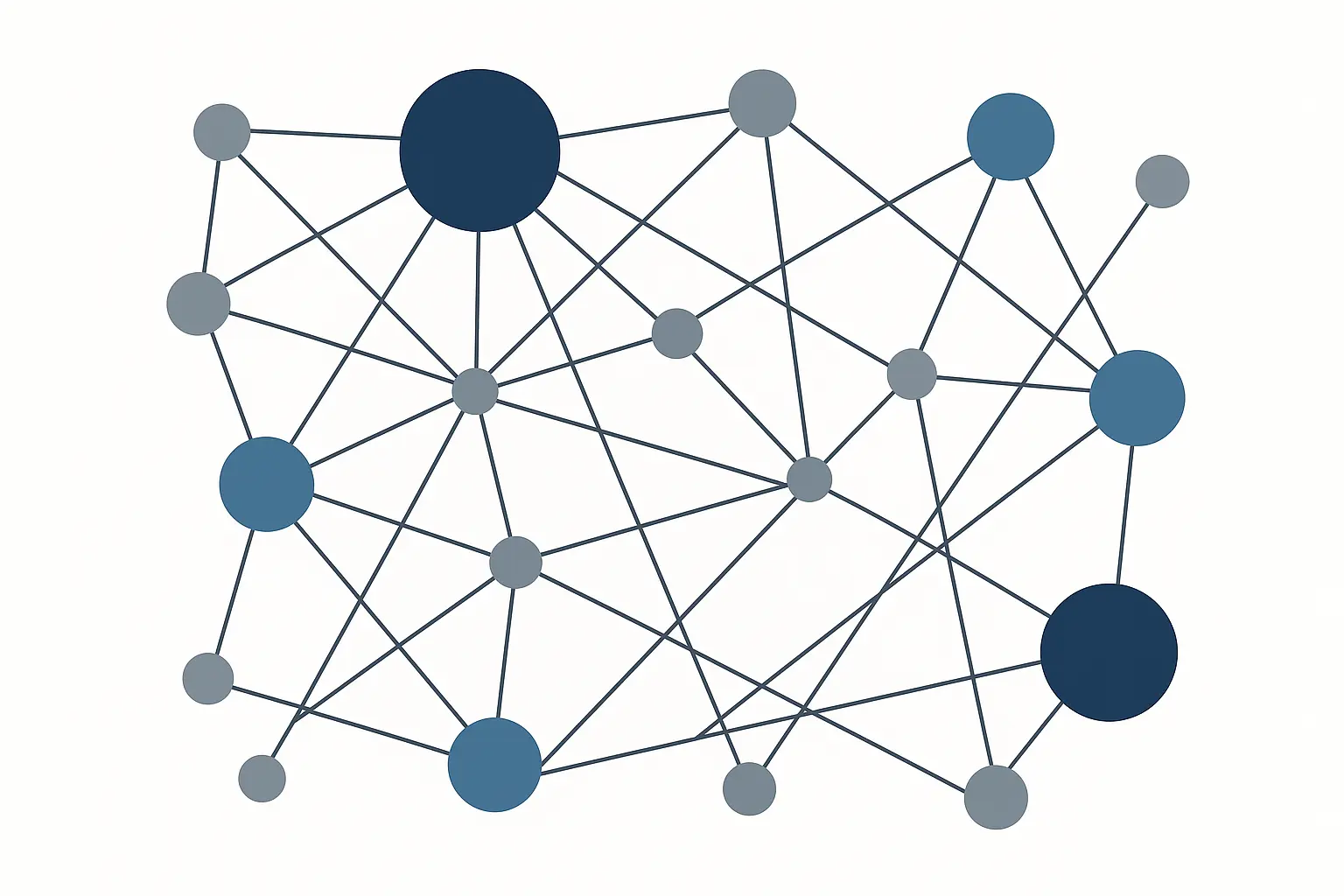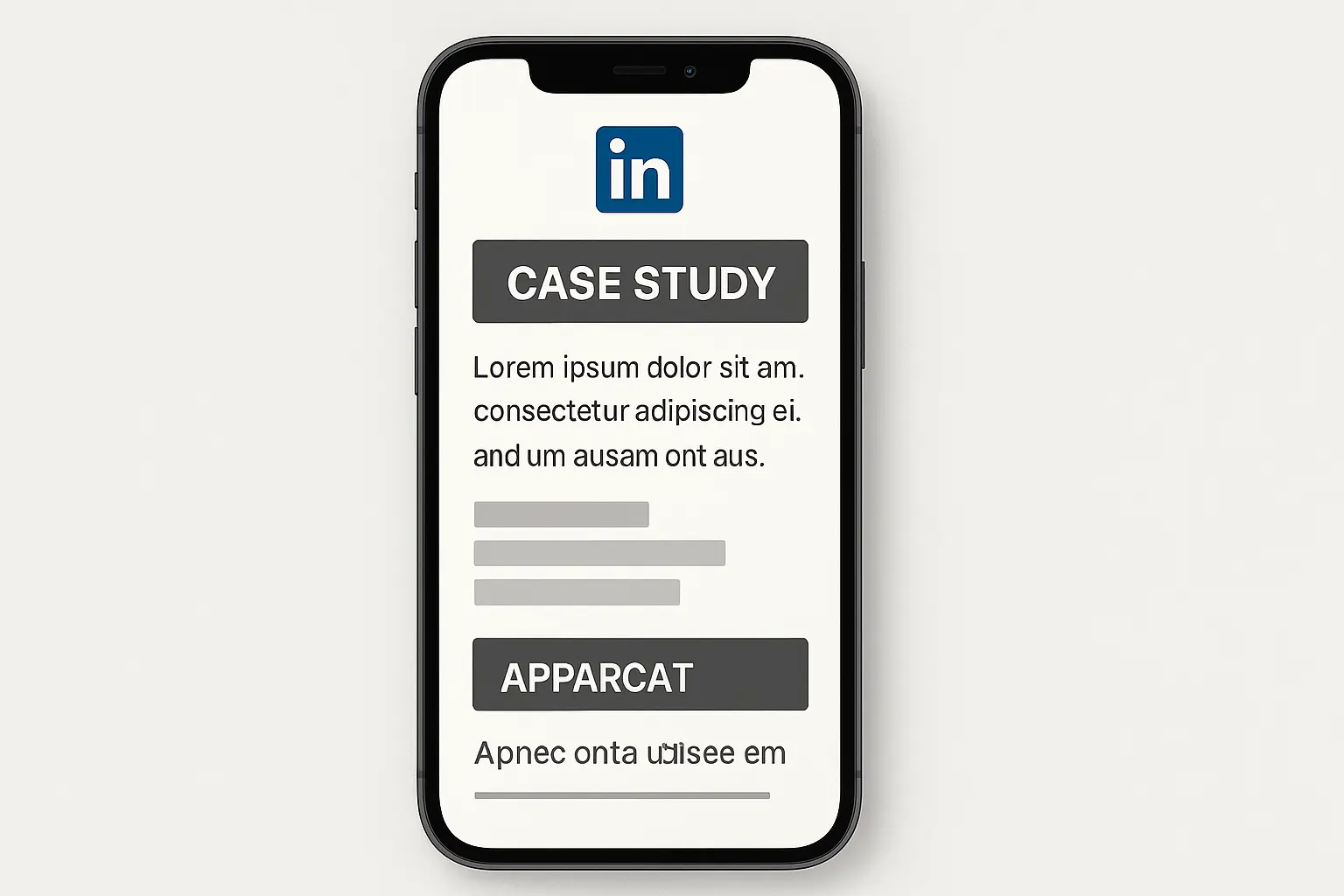LinkedIn’s got 1.2 billion members across 200+ countries, making it the go-to platform for B2B marketing. But here’s what drives me crazy – most agencies treat case studies like afterthoughts instead of the lead generation machines they could be.
I spent three years figuring this out the hard way. Now our LinkedIn case studies generate 40% of our new business inquiries. Not likes, not shares – actual paying clients.

Table of Contents
-
Strategic Framework Development
-
Case Study Architecture & Planning
-
Content Strategy & Narrative Construction
-
Implementation & Distribution Strategy
-
Performance Analytics & Optimization
-
Content Creation & Production
-
Legal & Ethical Considerations
-
Advanced LinkedIn Strategy Integration
-
How The Marketing Agency Can Help
-
Final Thoughts
TL;DR
Look, most people are doing LinkedIn case studies wrong. You need more than just “we got great results” – you need clear goals, specific audiences, and a system that actually generates leads, not just ego boosts.
The structure matters more than you think. Poor planning kills even the best results. Your visuals need to work on phones (because that’s where people actually see them), and you better be tracking real metrics like consultation requests, not vanity numbers.
Get your legal stuff sorted upfront – client approval processes save headaches later. And stop treating case studies as one-and-done posts. Smart agencies turn one client win into months of content across multiple platforms.
Strategic Framework Development
Look, I’ve watched too many agencies just wing it with case studies and then scratch their heads wondering why nobody’s calling. Here’s the thing – you need a real plan, not just “let’s post about that client win.”
I spent my first year creating these beautiful case studies that got tons of likes but zero business. Felt great for my ego, terrible for my bank account. That’s when I realized I was treating case studies like social media posts instead of what they actually are – sales tools.
Your case studies need to do heavy lifting. They’re not just there to make you look good (though that’s nice too). They need to attract the right people, prove you can solve their specific problems, and get them to actually reach out. Each one should be like having a salesperson working 24/7.
Similar to developing high-impact blog topics, your LinkedIn case study approach needs to account for how business decision-makers actually consume content. They’re not scrolling mindlessly like on Instagram. They’re looking for stuff that’ll actually help them do their job better or solve real problems.
Here’s what I wish someone had told me: decide what you want before you create anything. Are you trying to land more e-commerce clients? Get speaking gigs? Break into a new industry? Because a case study designed to impress other marketers looks completely different from one meant to convince a CEO to hire you.

Case Study Architecture & Planning
Setting Clear Goals (Not Fluffy Ones)
Every case study needs to answer this question: “What do I want to happen after someone reads this?” If your answer is vague like “build awareness,” you’re already in trouble.
I learned this lesson when I spent weeks on a gorgeous case study about a client’s 300% traffic increase. Got shared everywhere, people loved it. Know how many leads it generated? Zero. Because I never thought about who I was trying to reach or what I wanted them to do next.
Now I get specific. Really specific. Like “I want three SaaS companies with 50-200 employees to book discovery calls this month.” That level of clarity changes everything – from which client story you pick to how you write the headline.
Stop measuring success by vanity metrics. I don’t care if your post got 1,000 likes if none of those people can hire you. Track the stuff that pays bills: consultation requests, qualified conversations, actual proposals sent. Everything else is just noise.
This approach mirrors how we track marketing ROI – focusing on metrics that directly impact your bottom line, not just feel-good numbers.
|
Objective Type |
Key Metrics |
Success Indicators |
|---|---|---|
|
Lead Generation |
Demo requests, consultation bookings, qualified inquiries |
15+ qualified leads per case study |
|
Thought Leadership |
Speaking invitations, media mentions, industry recognition |
5+ industry mentions or speaking opportunities |
|
Brand Awareness |
Profile views, connection requests, brand searches |
25% increase in profile views |
|
Client Acquisition |
Proposal requests, RFP invitations, new client meetings |
3+ new client meetings per quarter |
Know Your Audience (Really Know Them)
This sounds obvious, but most people get it wrong. They think knowing someone is a “marketing director” is enough. It’s not.
You need to understand what keeps them up at night. Are they worried about getting fired? Trying to prove ROI to their boss? Dealing with a CEO who doesn’t “get” marketing? Because the case study that resonates with someone fighting for budget approval is totally different from one targeting someone looking to level up their skills.
I spend time actually talking to my ideal clients – not just analyzing data about them. What words do they use? What problems do they complain about? How do they consume content on LinkedIn?
Here’s something most people miss: decision-makers and influencers need different proof points. The CMO cares about revenue impact. The marketing manager cares about tactics they can actually implement. Same case study, different angles.
Don’t forget that these are real humans making decisions with company money. They’ve got fears, aspirations, and biases just like everyone else. Your case studies need to address both the logical stuff (ROI, metrics, process) and the emotional stuff (fear of making the wrong choice, desire to look smart to their boss).
Competitive Analysis (Without Copying)
Your competitors are already sharing case studies, and some of them are probably doing it better than you. That stings, but it’s useful information.
I regularly stalk – I mean, research – what my competitors are posting. Not to copy them, but to find gaps. Maybe they’re all focused on big enterprise clients, leaving an opening for small business stories. Or they’re obsessed with vanity metrics while ignoring ROI.
One thing I noticed: most agencies in my space were sharing these super polished, corporate-feeling case studies. So I went the opposite direction – more behind-the-scenes, honest about challenges, showing the messy reality of client work. Turns out, people were hungry for that authenticity.
Pay attention to the engagement their posts get. Which case studies generate actual conversations versus just polite likes? What topics seem to hit a nerve with their audience? This intelligence helps you avoid creating content that falls flat.
Here’s a real example: A marketing agency discovered that all their competitors were focusing on vanity metrics in their case studies. They differentiated themselves by exclusively showcasing revenue attribution and ROI metrics, positioning themselves as the “results-focused” agency. This led to a 40% increase in qualified leads from decision-makers who were tired of agencies that couldn’t prove business impact.
Content Strategy & Narrative Construction
The Problem-Solution Thing Actually Matters
Here’s where most case studies fall apart: they jump straight to the impressive results without explaining why those results matter. “We increased their traffic by 400%!” Okay, cool. But why should I care?
The problem section is where you hook people. Make it specific and painful. Not “client needed more leads” but “client was spending $10K/month on ads and getting 3 qualified leads.” Now we’re talking.
When you’re explaining your solution, don’t just list what you did. Walk people through your thinking. Why did you choose that approach over the obvious alternatives? What did you see that others missed? This is where you demonstrate expertise, not just execution.
I used to be scared to share too much detail, thinking competitors would steal my strategies. Then I realized something: knowing what to do and actually doing it well are completely different things.
Your results section needs to be specific and credible. Don’t say “significantly improved performance.” Say “increased qualified leads from 12 per month to 47 per month while reducing cost per lead by 34%.” Specific numbers build trust.
Making Data Actually Interesting
Raw numbers are boring. “Increased conversion rate by 23%” makes people’s eyes glaze over. But “helped them go from 2 sales per month to 15 sales per month” – now you’ve got their attention.
Most people consume LinkedIn content on their phones while waiting for coffee or sitting in meetings. Your charts and graphs need to work on a tiny screen, or they’re useless. I learned this after creating these beautiful infographics that looked amazing on my laptop but were completely unreadable on mobile.
Keep it simple. One key point per visual. Big fonts. High contrast. If your mom can’t read it on her phone, it needs work.
Choose the right chart type for your data. Bar charts work great for comparisons, line graphs show trends over time, and pie charts (use sparingly) can illustrate proportions. Don’t force complex data into the wrong visual format just because it looks cooler.

B2B Storytelling (Without Being Boring)
B2B buyers are still humans. They have emotions, fears, and biases just like everyone else. But they’re making decisions with company money, so they need logical justification too.
Client testimonials are gold, but only if they’re specific. “Working with them was great!” tells me nothing. “They identified a conversion issue we’d been missing for months and fixed it in two weeks, which saved our Q4” – now that’s useful.
Share the stuff that went wrong too. Not the disasters that make you look incompetent, but the normal challenges every project faces. How did you handle it when the client changed direction mid-campaign? What did you do when the initial strategy wasn’t working? This transparency builds trust.
Behind-the-scenes insights fascinate business audiences. They want to see your strategic thinking process, understand the decisions you made and why. This positions you as a strategic partner, not just someone who executes tactics.
Multi-Format Content Planning
One case study should fuel multiple pieces of content across different LinkedIn formats. This maximizes your investment and reaches people who prefer different content types. Some folks love quick carousel posts, others want detailed articles.
Carousel posts work incredibly well for case studies because you can break down complex information into digestible slides. Each slide should focus on one key point with compelling visuals and minimal text. The swipe-through format keeps people engaged longer than static posts.
Video content performs strongly on LinkedIn, especially for case studies. Create short videos highlighting key results, client testimonials, or behind-the-scenes footage. Even simple screen recordings walking through your process can be highly engaging. “LinkedIn recently reported that video watch time rose 36% year-over-year in 2024” Social Media Today, showing the growing importance of video content on the platform.
Long-form LinkedIn articles allow for deeper storytelling and better SEO visibility. Use articles to provide comprehensive case study details that support your shorter-form content. These articles also help with LinkedIn’s publishing algorithm.
Implementation & Distribution Strategy
Publishing Timeline & Sequencing
Don’t just post your case study once and call it done. That’s leaving money on the table. I typically plan a 2-3 week content sequence around each major case study to extract maximum value.
Start with a teaser post that hints at impressive results without revealing everything. Something like “Just wrapped up a campaign that took a client from 50 to 500 qualified leads per month. The strategy we used might surprise you…” This creates curiosity and primes your audience.
The main case study post should be your comprehensive piece with the complete problem-solution-results framework. This becomes your anchor content that you’ll reference in future posts.
Follow-up posts can dive deeper into specific aspects. Maybe one post focuses on the creative strategy, another on the data analysis, and a third on lessons learned. Each post provides value while reinforcing your main message.
LinkedIn Algorithm Optimization
LinkedIn’s algorithm rewards content that generates meaningful professional conversations. Your case study posts need to encourage comments and discussions, not just passive consumption. I structure my posts with questions and conversation starters that prompt engagement.
Timing matters more than most people realize. LinkedIn users have distinct patterns – typically higher engagement during business hours and early evenings. I’ve found Tuesday through Thursday, between 8-10 AM and 5-7 PM, generate the strongest engagement for case study content.
The first hour after posting is critical. LinkedIn measures early engagement velocity to determine how widely to distribute your content. I give my team and key clients a heads up before posting so they can engage quickly and boost initial momentum.
Native LinkedIn content performs better than external links. Instead of linking to a case study on your website, create the full case study within LinkedIn’s platform. You can always include a subtle call-to-action directing interested readers to your website for more information.

Performance Analytics & Optimization
Tracking Stuff That Actually Matters
Engagement is nice, but it doesn’t pay rent. I track how many consultation requests each case study generates, how many of those turn into proposals, and how many close. That’s the data that matters.
A post with 50 thoughtful comments from qualified prospects is way more valuable than 500 likes from random connections. I track engagement quality, not just quantity. Comments indicate genuine interest and provide opportunities for relationship building.
LinkedIn’s lead gen forms are pretty slick for case studies. People can express interest without leaving the platform, which means higher conversion rates. Just make sure you’re actually following up quickly – nothing kills momentum like waiting three days to respond.
Here’s something I track that most people ignore: lead quality by case study type. I found that case studies featuring specific ROI percentages generated way better leads than ones with vague “improved performance” claims. Now every case study includes concrete numbers.
Use UTM parameters on any external links and ask new prospects how they found you during initial conversations. Many clients mention specific case studies that caught their attention. This tracking approach is similar to how we measure SEO ROI to understand which initiatives drive the most business value.
“A quarter of users interact with brand content daily” Sprout Social, highlighting the significant opportunity for meaningful engagement if you’re creating the right content.
|
Objective Type |
Key Metrics |
Success Indicators |
|---|---|---|
|
Lead Generation |
Demo requests, consultation bookings, qualified inquiries |
15+ qualified leads per case study |
|
Thought Leadership |
Speaking invitations, media mentions, industry recognition |
5+ industry mentions or speaking opportunities |
|
Brand Awareness |
Profile views, connection requests, brand searches |
25% increase in profile views |
|
Client Acquisition |
Proposal requests, RFP invitations, new client meetings |
3+ new client meetings per quarter |
Testing and Improving
I test everything. Headlines, post formats, even the order I present information. Small changes can make huge differences in engagement and lead generation.
Headlines are crucial because they determine whether people stop scrolling. I’ve seen 40% differences in engagement based solely on headline variations. Questions vs. statements, specific numbers vs. general claims, emotional hooks vs. data-driven approaches – test it all.
Post timing matters more than people think. Your audience might be completely different from the general “LinkedIn best practices.” I found my audience is most active Tuesday afternoons and Thursday mornings. Your mileage may vary.
Visual formats need testing too. Some audiences prefer clean, minimalist designs while others respond better to bold, colorful graphics. Test carousel posts against single images, video thumbnails against static graphics, and different chart styles for data presentation.
Comments on your case studies provide valuable feedback and relationship-building opportunities. I treat every comment as a chance to start a meaningful conversation. Thoughtful responses often lead to private messages and eventually business discussions.

Content Creation & Production
Visual Design & Brand Consistency
Creating design templates saves time and ensures consistency across all your case studies. I’ve developed a library of templates for different formats – carousel posts, infographics, video thumbnails, and article headers. Each template maintains our brand identity while allowing for customization.
Your template system should include guidelines for typography, color usage, spacing, and logo placement. This ensures anyone on your team can create on-brand visuals without starting from scratch each time. Consistency builds brand recognition and professionalism.
Different industries might need template variations. A case study for a tech startup might use different visual elements than one for a healthcare organization. Build flexibility into your system while maintaining core brand elements.
|
Template Type |
Use Case |
Key Elements |
Customization Level |
|---|---|---|---|
|
Carousel Post |
Quick results overview |
5-7 slides, key metrics, visual hierarchy |
Medium – colors and icons |
|
Infographic |
Detailed data presentation |
Charts, graphs, process flows |
High – industry-specific imagery |
|
Video Thumbnail |
Video case studies |
Bold text, compelling visual |
Low – text and background only |
|
Article Header |
Long-form content |
Professional layout, client logo space |
Medium – industry themes |
Mobile-First Visual Optimization
Mobile optimization isn’t optional – it’s essential. Over 70% of LinkedIn users access the platform primarily on mobile devices. Your case study visuals need to be readable and engaging on small screens, or you’ll lose most of your audience.
Font sizes need to be larger than you think. Text that looks perfect on your desktop monitor might be unreadable on a phone. I use minimum 14-point fonts for body text and 18-point for headlines in case study graphics.
Simplify your designs for mobile consumption. Complex infographics with multiple data points become cluttered and confusing on small screens. Break complex information into multiple slides or graphics rather than cramming everything into one visual.
Test your visuals on actual mobile devices, not just by resizing your browser window. Colors, contrast, and readability can appear different on various phone screens. I check every case study visual on both iOS and Android devices before publishing.

Legal & Ethical Considerations
Client Approval (Don’t Skip This)
Get approval in writing. Always. I include case study rights in our initial contracts now because asking for permission after the fact is awkward for everyone.
Some clients want their names kept confidential, which is totally fine. “Mid-sized SaaS company” can be just as compelling as naming the actual client. Focus on the industry, company size, and challenge type rather than specific company names.
Document everything. Email approval is usually fine, but keep it organized. You don’t want to be scrambling through old emails six months later trying to prove you had permission to use something.
Develop a standardized approval process that’s easy for clients to navigate. I send a draft case study with specific approval checkboxes for different elements – company name usage, specific metrics, visual elements, and distribution channels. This clarity prevents misunderstandings.
Data Privacy & Compliance Standards
Data privacy regulations affect what client information you can share publicly. GDPR, CCPA, and industry-specific regulations may limit what data you can include in case studies. When in doubt, consult with legal counsel rather than risk compliance violations.
Aggregate data is generally safer to share than specific individual metrics. Instead of sharing exact conversion numbers, consider sharing percentage improvements or ranges. This provides compelling proof while reducing privacy risks.
Industry-specific regulations may impose additional restrictions. Healthcare, financial services, and government clients often have stricter requirements for public information sharing. Understand these requirements before creating case studies for regulated industries.
Intellectual Property Protection
Protect your proprietary methodologies while still demonstrating expertise. You can share high-level strategic approaches without revealing specific tactics or tools that provide competitive advantages. Focus on results and general methodology rather than detailed implementation.
Client intellectual property requires careful handling. Avoid sharing proprietary client information, internal documents, or strategic plans that could benefit competitors. Stick to publicly available information and results that don’t reveal sensitive business details.
Monitor for unauthorized use of your case studies. Set up Google Alerts for your company name and key case study phrases. When you find unauthorized usage, address it promptly through direct contact or legal channels if necessary.
Advanced LinkedIn Strategy Integration
Getting Clients to Share Your Stuff
When clients share your case studies, magic happens. Their networks see third-party validation that money can’t buy. Plus, LinkedIn’s algorithm loves it when multiple people engage with your content quickly.
I always ask satisfied clients if they’re willing to share our case study posts. Most are happy to do it if you make it easy for them. Provide suggested language, but encourage them to add their own perspective about working with your agency.
Some clients will even create their own posts about working with you. These client-generated case studies often perform better than anything you create yourself because they’re coming from an authentic client perspective.
Coordinate the timing of client shares with your original post. When clients comment on and share your case study within the first few hours of posting, it signals to LinkedIn’s algorithm that the content is valuable and worth distributing more widely.
The success of Vector’s LinkedIn influencer marketing campaign demonstrates this principle perfectly. “Vector shared that their $12,000 LinkedIn influencer marketing experiment turned into $1.1 million in pipeline” Favikon, showing how strategic client and influencer collaboration can generate extraordinary results.
Team Member Amplification
Your team members are your best content amplifiers. Each team member has their own LinkedIn network, and their shares expose your case studies to new audiences. I encourage all team members to share case studies with their own commentary about their role in the project.
Different team members can highlight different aspects of the same case study. The account manager might focus on client relationship aspects, the strategist on methodology, and the analyst on data insights. This provides multiple angles on the same success story.
Create a content sharing calendar that coordinates team member amplification. Stagger shares over several days rather than having everyone share simultaneously. This extends the content’s lifespan and reaches different audience segments at optimal times.

Cross-Platform Integration
Your LinkedIn case studies shouldn’t live in isolation. I repurpose them for email newsletters, blog posts, sales presentations, and proposal attachments. One good case study can fuel content for months.
Email marketing should reinforce your LinkedIn case studies. I include case study highlights in our monthly newsletter and create dedicated email campaigns around major case studies. This reaches subscribers who might have missed the LinkedIn content.
Create detailed versions on your website for SEO purposes. Use relevant keywords, optimize for search, and gate comprehensive case studies behind email capture forms. This helps prospects find you organically and builds your email list, similar to how we develop strategic blog topics that reinforce our core messaging across channels.
Your sales team should be armed with case study ammunition. Train them to reference specific case studies during prospect conversations. Instead of generic cold outreach, they can lead with “I saw you’re dealing with [specific challenge]. We just helped a similar company achieve [specific result]…”
Create case study one-pagers for sales meetings and networking events. These condensed versions highlight key results and can be shared easily during in-person conversations. They serve as leave-behinds that prospects can reference after meetings.

How The Marketing Agency Can Help
Creating effective LinkedIn case studies requires more than just good storytelling – it demands a strategic, data-driven approach that aligns with your business objectives. The Marketing Agency understands that your case studies need to generate leads, build credibility, and demonstrate ROI, not just collect likes and comments.
Our team combines strategic thinking with tactical execution to create case study programs that actually move the needle for your business. We handle everything from client approval processes and legal compliance to visual design and performance optimization. This comprehensive approach ensures your case studies work as integrated marketing tools rather than isolated content pieces, similar to how we approach advanced analytics for strategic growth.
What sets our approach apart is our focus on measurable outcomes. We don’t just create beautiful case studies – we build systems to track lead generation, conversion rates, and revenue attribution. Our AI-enhanced analytics help identify which case studies drive the most business value, allowing us to optimize your program for maximum ROI.
Ready to transform your client successes into a lead generation machine? Our LinkedIn case study program includes strategic planning, content creation, distribution optimization, and performance tracking. We’ll help you build a systematic approach that generates qualified leads while establishing your thought leadership in your industry.

Final Thoughts
LinkedIn case studies are one of the most powerful yet underutilized tools in B2B marketing. When done right, they transform your client successes into lead generation machines that work around the clock. The key is approaching them systematically rather than as one-off content pieces.
The framework I’ve outlined here isn’t theory – it’s based on real experience creating case studies that generate actual business results. Every element, from strategic planning to performance optimization, serves a specific purpose in building your professional reputation and attracting qualified prospects.
Don’t rush the process or cut corners on client approval and legal compliance. The investment you make in creating high-quality, strategic case studies will pay dividends in credibility, leads, and business growth.
Start with one well-executed case study rather than trying to create multiple mediocre ones. Focus on demonstrating clear business impact, telling a compelling story, and optimizing for your specific audience. Once you have a proven framework, you can scale your approach systematically.
Your client successes are your most powerful marketing assets. Use them strategically, measure their impact, and continuously optimize your approach. The businesses that master LinkedIn case studies will have a significant competitive advantage in attracting and converting high-quality prospects.



